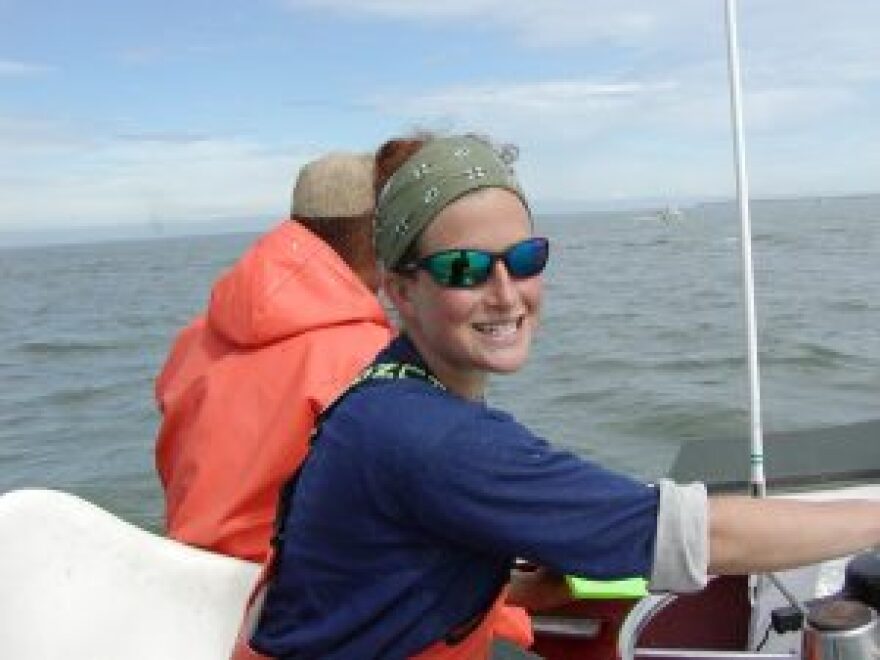Pebble Mine opponent Lindsey Bloom thought she had the goods.
When she saw a video showing an executive from Pebble's parent company make a pitch to potential investors, she considered it proof of what fishermen and environmental groups have been warning - that Pebble is minimizing the scope of the project, but that ultimately it expects to build a more damaging operation.
"One of the ways you ensure you can get a permit is you de-risk it by taking something modest and conservative into the permitting process in the first place. And we did that," Northern Dynasty Vice President Doug Allen says on the video, filmed at a conference in Toronto in late February.
“Because for whatever reason, cyanide has a bad reputation in the environmental community. And so we have forgone about 12% of our gold recovery, because we don’t have a secondary gold-recovery circuit," he said. "That’s not necessarily gold lost. We hope it’s gold deferred, because we at a subsequent date will get a permit to add a secondary gold-recovery circuit.”
Bloom, who works for Commercial Fishermen for Bristol Bay, believes that to be evidence of Pebble's duplicity.
“Who are you lying to, Alaskans or investors? Because you can't have it both (ways)," she said. "It can't be a small mine and a big mine. You can't use cyanide and not use cyanide.”
Bloom thought the video would make headlines. She sent a transcript to multiple news outlets more than a week ago. And then … crickets.
“I haven't been hearing anything back from reporters. You're the first one I've talked to," she said. "And I just think that, I don't know, the airwaves are so crowded right now. So much going on in the world.”
Environmentalists say the Trump administration is taking advantage of the coronavirus pandemic to advance Pebble as well as other Alaska projects and anti-conservation policies, while the public and the press are distracted. Until COVID-19 poses less of a threat, they've asked the government to hit the pause button on a host of issues:
-Exempting the Tongass National Forest from the Roadless Rule
-An auction of drilling rights in the Arctic National Wildlife Refuge
-Rolling back restrictions on hunting and trapping in National Preserves
-Allowing brown bear baiting in the Kenai National Wildlife Refuge
-The plan to develop Willow, a site in the National Petroleum Reserve-Alaska, near the village of Nuiqsut, that could have as many as 250 oil wells
Nicole Whittington-Evans, Alaska director for Defenders of Wildlife, says she's disturbed the Bureau of Land Management chose to proceed with public meetings last month on the Willow development. She says people can't provide meaningful input now.
Instead of the in-person meetings in a series of communities, the BLM had eight Zoom sessions. Whittington-Evans says it suppressed public comment.
"It really switched the power dynamic, incredibly, during these hearings, in terms of who had the control, who would be allowed to speak when when you could actually ask questions and not ask questions," she said.
One man’s microphone was muted as he was providing his opinion, Whittington-Evans said. He was swearing, she acknowledged, and if it was an in-person meeting he probably would have been asked to leave. But, she said, he would not have been muted.
"You can't just, like, hold your hand over somebody's face in a public hearing," she said.
BLM spokeswoman Lesli Ellis-Wouters said muting was employed once. She said the agency has a responsibility to keep the session suitable for all ages.
Zoom can’t replicate an actual meeting, but it allows for social distancing, and it has some big advantages when it comes to discussing Arctic projects, Ellis-Wouters said.
“One that stuck with me, I think it was our very first meeting, we had participation from Southeast, which had never been done at an in-person meeting before," Ellis-Wouters said. "And we also, on that same call, we have somebody from Utqiagvik. There's 1,000 miles in between those two communities, and they were able to come to the same meeting. So we were getting perspectives from people that we traditionally have not heard from before.”
The eight Zoom sessions on Willow drew about 400 unique views, plus another 2,000 views on Facebook live, Ellis-Wouters said. That suggests that far more people tuned in than attended the original set of community meetings that took place pre-pandemic, she said.
In the Zoom sessions, a lot of the Willow opponents said the format, or proceeding at all during a pandemic, was unfair. Project supporters, on the other hand, described it as a brilliant way to do public engagement.
As for Pebble, spokesman Mike Heatwole declined to be interviewed, but he said in an email that Pebble has no current plans to use cyanide. He also pointed out the public input period on the mine ended last year.
At this phase, the U.S. Army Corps of Engineers is working with its cooperating agencies on the final phases before it decides on issuing permits.
One of those cooperating agencies is the Curyung tribe of Dillingham, but its leaders say they have no time to co-operate.
“All of our tribal focus right now has become COVID and maintaining the health and safety of our people here in Bristol Bay," said tribal administrator Courtenay Carty.
Thousands are flooding into the area to work in the fishery, and the first positive test has already emerged. Carty said she can't keep up with the Pebble documents or attend the biweekly meetings of cooperating agencies now.
“And so we're really disenfranchised at this point in time," she said. "To (not) be able to focus on something as important as the Pebble permitting process, that we've dedicated over a decade to, to have it come to decision essentially over summer, in the midst of a global pandemic is unfathomable.”
The executive from Pebble's parent company told potential investors they expect to have a federal permit by August.



